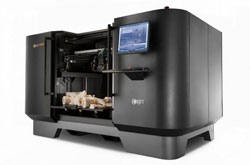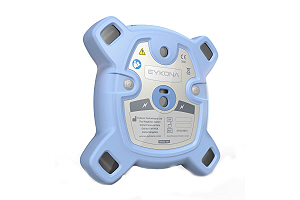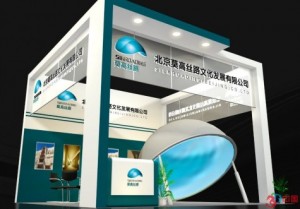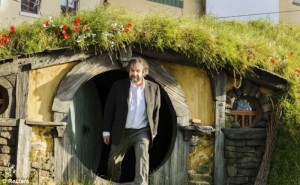CAMERON- NEW HOBBIT MOVIE WILL CHANGE THE INDUSTRY
Jackson this week likened the higher shooting rate to the introduction of compact discs, saying it was the way of the future for film. "I personally think it's fantastic, but it's different," he told Radio New Zealand. "I remember when CDs came in and there was a nostalgic feeling that the sound of a needle on vinyl was what music should sound like -- suddenly you've got this pristine clarity and a lot of people were nay-saying it."
See the full story here: http://www.3dtv.com/news/Cameron-New-Hobbit-movie-will-change-the-industry
Objet Launches A Large-Format 3D Printer
 Rehovot, Israel – Objet Ltd., the innovation leader in 3D printing for rapid prototyping and additive manufacturing, launched today at Euromold the Objet1000, the company’s largest 3D printer to date. Featuring a 1000 x 800 x 500 mm (39.3 x 31.4 x 19.6 inch) wide-format build envelope, the Objet1000 is ideal for automotive, defense and aerospace, industrial machinery, consumer goods and household appliance sectors as well as high-end service bureaus that need to create industrial size, 1:1 scale prototypes.
Rehovot, Israel – Objet Ltd., the innovation leader in 3D printing for rapid prototyping and additive manufacturing, launched today at Euromold the Objet1000, the company’s largest 3D printer to date. Featuring a 1000 x 800 x 500 mm (39.3 x 31.4 x 19.6 inch) wide-format build envelope, the Objet1000 is ideal for automotive, defense and aerospace, industrial machinery, consumer goods and household appliance sectors as well as high-end service bureaus that need to create industrial size, 1:1 scale prototypes.
Custom 3D-Printed Beams Can Be 10,000 Times Stronger Than Steel
 If you start 3D-printing custom beams for the exact purpose they're intended to serve though, you've got a regular space-age material on your hands. It's lighter than steel and orders of magnitude stronger.
If you start 3D-printing custom beams for the exact purpose they're intended to serve though, you've got a regular space-age material on your hands. It's lighter than steel and orders of magnitude stronger.
With each iteration of ever-smaller fractal innards, the beam can gain strength by the order of magnitude, with practically negligible weight gain. Third generation beams, about as far as we can hope to go with current tech, are 10,000 times stronger than steel.
See the full story here: http://gizmodo.com/5964609/custom-3d+printed-beams-can-be-10000-times-stronger-than-steel
Active vs. passive vs. glasses-free 3D TVs
[Philip Lelyveld comment: a long time getting to the obvious conclusion that glasses-free aren't developed sufficiently for the consumer market yet.]
It has been almost three years since 3D TVs first appeared in the consumer market. Now, there are three predominant 3D display technologies used by the TV manufacturer. Panels based on active shutter 3D goggles are the first to arrive on the home 3D entertainment scene. This was quickly followed by their passive 3D glasses counterparts, as well as glasses-free versions which have only been recently debuted.
Conclusion
At this point in time, an active shutter or passive 3D TV is probably a more logical choice for most users. Aside from a higher price premium, most active shutter 3D TVs can deliver good picture quality in darker rooms. If you have a limited budget, nothing beats passive 3D displays with their equally strong 3D visuals, save for the visible artifacts at close viewing distances.
With better performance and affordability, glasses-free 3D panels will be a lot more appealing, but not for now.
See the full story here: http://asia.cnet.com/active-vs-passive-vs-glasses-free-3d-tvs-62219631.htm
Using a 3D Printer to Make Parts from Moon Rock
Imagine landing on the moon or Mars, putting rocks through a 3D printer and making something useful – like a needed wrench or replacement part.
To test the idea, NASA researchers provided Bandyopadhyay and Bose with 10 pounds of raw lunar regolith simulant, an imitation moon rock that is used for research purposes.
The WSU researchers were concerned about how the moon rock material, which is made of silicon, aluminum, calcium, iron and magnesium oxides, would melt, but they found it behaved similarly to silica. And, they built a few simple shapes.
See the full story here: http://www.pddnet.com/news/2012/11/using-3d-printer-make-parts-moon-rock
3D camera helps wound assessment in Afghanistan
 A portable 3D imaging camera developed by an Oxford based medical technology company is being used in Afghanistan to assess the nature of wounds received by soldiers.
A portable 3D imaging camera developed by an Oxford based medical technology company is being used in Afghanistan to assess the nature of wounds received by soldiers.
The Eykona camera – shortlisted for Electronic Product of the Year in the 2011 British Engineering Excellence Awards – creates a detailed 3D model of any wound or scar, from which accurate measurements of distance, area, colour, width or volume can be made.
This model can then be assessed from all angles using rendering software and shared with other doctors and clinicians. Small sterile 'targets' allow the focus and position of the camera to be set, eliminating inconsistency between images.
Using the models created using the camera, medics can assess fresh wounds and understand if and how the wound is healing, allowing them to adjust the treatment plan accordingly.
See the full story here: http://www.newelectronics.co.uk/electronics-news/_3d-camera-helps-wound-assessment-in-afghanistan/46436/

